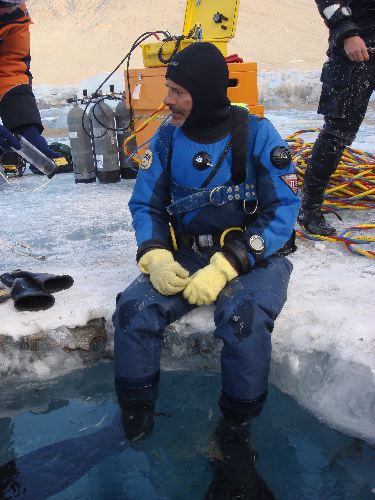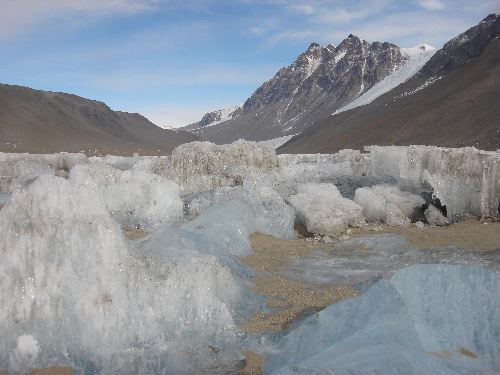The day started with some "helo support" to help move some heavy equipment from near camp to a spot on the lake. It's impressive to watch the helo crews operate; check out the video for a quick glimpse.
http://
All the "pieces" have come together and the reason we are here is starting to play out! The compressor arrived today, so I can now fill the dive tanks! The compressor basically sucks air out of the sky and forces it into the dive tanks. The blue circle on the left side of the picture is the intake valve which filters the air so that the air going into the tanks is clean fresh air!
 283compressor.JPG
283compressor.JPG
The Compressor
The tanks are filled to 2400 psi (pounds per square inch). We have two sets of double tanks which will be filled and hooked up to the "talk box" and then to the umbilical cord so the diver can have a fairly long supply of air! As we use up one set of doubles, we transfer to the next set.
 284compguage.JPG
284compguage.JPG
Not quite full; it's got to get to 2400 psi
 282talkbox.JPG
282talkbox.JPG
The "Talk Box." The red and blue hoses on the left are each connected to a set of double tanks. The gauges to the left of the hoses tell how much air is left in the tanks - it's important to keep an eye on those gauges! The round knobs to the right of the hoses turn them on and off. We can have one on, use up the air supply in that set of tanks and then turn the other one on to use the second set of doubles. The top left square is the communications section of the box. The diver can talk with the people on the surface and the surface folks can talk to the diver; it's good to have communication. The large gauge on the top right is for the pneumo hose. This is an open ended hose that we can use to fill lift bags and/or sample tubes with air while underwater. We can also tell how deep the diver is with the gauge. The valve on the bottom right is the "on/off" switch to the air supply to the diver. It's best to have that valve in the "on" position!
Ian and Aslan got suited up to dive. Aslan went in first and took light sensor readings in various positions under the ice. This will allow the researchers to know how much light is reaching the algal mat in that particular area and at various depths. When you're dealing with photosynthetic organisms, it's important to know how much light is getting to the area of interest.
 286hilkelightsensor.JPG
286hilkelightsensor.JPG
As Aslan dove, Hilke recorded the light levels at the various positions where Aslan held the sensor. I was working the talk box, so Hilke would tell me when she got the reading, I would tell Aslan to move to the next spot and he would tell us when he had arrived at the next spot and was ready to hold the sensor. It was a team effort!
After a successful dive by Aslan, Ian went in to choose a spot to put "Hal" tomorrow. Hal is a device that can probe the algal mat via surface controls. This saves having to have divers in the water which helps to protect and preserve the existing algal mat. Ian also took a water sample and an algal mat sample.
 287iangettingfready.JPG
287iangettingfready.JPG
Ian gets ready to dive.
 288aslancrunchy.JPG
288aslancrunchy.JPG
Aslan is the back-up diver/tender for Ian as he dives. Aslan's suit iced up as soon as he got out of the water; the air is cold! Luckily the dry suit garments that are worn underneath the suit are quite warm!
I wanted to leave you with some photos of the lake ice; it's simply beautiful!
 285lakand1882.JPG
285lakand1882.JPG
Rough surface ice! The tallest mountain in the background is about 4 miles away and is 1882 meters tall.
 280canadaglacierice.JPG
280canadaglacierice.JPG
Looking back towards the Canada glacier.
 290icebubbles
290icebubbles
Bubbles in the ice.
 278iceslab.JPG
278iceslab.JPG
Some ice that was chipped out of the dive hole. You can see the gas bubble tubes within the ice.
 289lakeice.JPG
289lakeice.JPG
The ice is an amazing blue color. It's quite mesmorizing; I could sit and just look at it for hours. The patterns are fantastic!
You can also check out my journals and pictures from previous seasons at: http://www.ryejrhigh.org/ellwood

